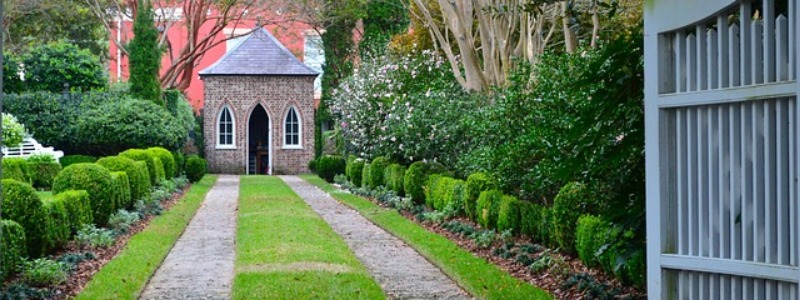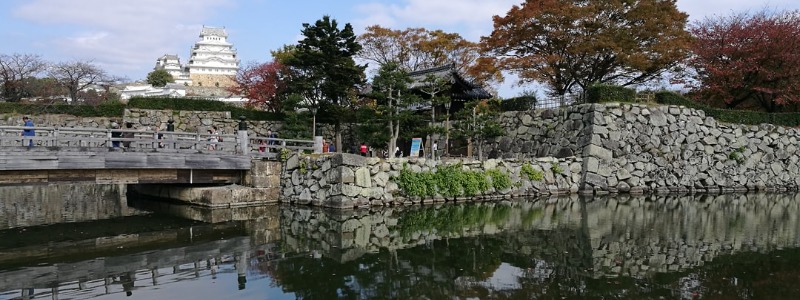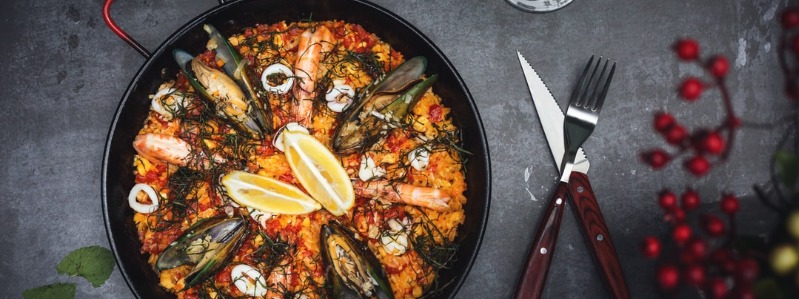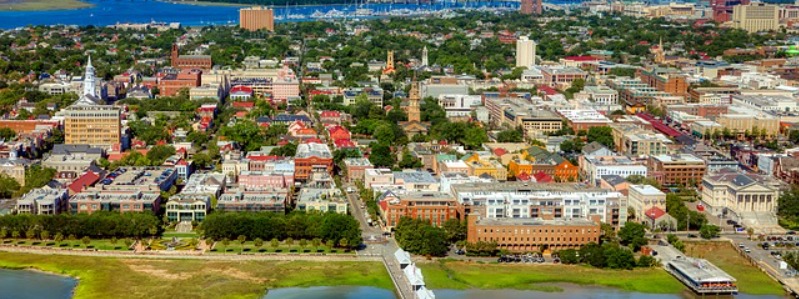Charleston, one of America’s oldest cities, is steeped in history. Roaming around downtown’s narrow cobblestone streets that open up to the sea transports you to another era, with several landmarks and monuments commemorating the city’s triumphs and tragedies.
From its covered market that stretches for four city blocks to its seawall walk that gives views of the harbor and island forts, Charleston is a city that invites ambling. An absence of hills means that you can cover the whole historic district quite easily on foot and, like the locals, at a leisurely pace. If you get tired there are free trolleys to hop on and off.

Or take a carriage ride and get an interesting commentary about points along the hour-long route. Anecdotes range from “George Washington slept here” to explanations about curious architectural details, such as why many outdoor porches have solid front doors.
Waterfront Park
The oldest part of town is a warren of small cobbled streets leading down to Waterfront Park. The buildings are attractively restored row houses, shops and art galleries like The Pink House (circa 1690) and the much-photographed Rainbow Row, made up of rehabilitated commercial buildings. This area was once one of only a few walled towns in North America, but unlike Quebec City, the walls were dismantled as Charleston grew beyond them.
Nathaniel Russell House Museum
This meticulously restored early-nineteenth-century mansion, complete with manicured gardens and architectural splendor, exemplifies the wealth of those who benefited the most from America’s transformation into a republic. The attention to detail in reproducing the era’s details is breathtaking. Visitors will discover, nevertheless, that while the owners lived in lavishness, Africans were enslaved on this property. Charleston, as a city, and in places like this museum, is grappling with how it recounts its history in order to understand its future.
Historic Churches
Steeples are a prominent feature of the skyline and Charleston is nicknamed “The Holy City” because it claims over 100 houses of worship. Many of the historic churches, temples and synagogues offer tours to visitors.
In the 1800s Charleston prospered as a genteel city of broad, tree-lined avenues and sumptuous mansions. Six of these, scattered around the city, are open for guided tours that reveal the grandeur of colonial and ante-bellum life. The interior of one of them, Calhoun Mansion, will seem familiar if you saw the film of Nicholas Spark’s novel, The Notebook.
Fort Sumter
The first shots of the Civil War were fired at Fort Sumter, a National Historic Site, reached by boat from Liberty Square near the impressive South Carolina Aquarium. Detour here to see turtles, stingrays, sharks, otters, alligators and even ring-tailed lemurs. Then enjoy a half hour cruise to the fort and an hour exploring the battlements and museum.

After the Civil War, or the “recent unpleasantness” as locals quaintly call it, the city was too destitute to tear down and rebuild, so many fine structures, though damaged, were left intact. Generations of civic-minded individuals and stringent heritage preservation by-laws have resulted in Charleston becoming a leading North American example of historic preservation and a lovely place to visit.
We visited Charleston with my sister and her family because there was something of interest for everyone. Historic architecture captivated the heritage buff. Tours of Fort Sumter’s battlements and Patriot Point’s aircraft carrier, the Yorktown, satisfied the military enthusiast. Nearby Magnolia Plantation and Gardens attracted the avid bird-watcher in our party. There was drama at the Dock Street Theatre and excellent small galleries for an arts fix. Even my toddler appreciated the boundless opportunities for long walks and horse-drawn carriage rides.
Charleston City Market
When visiting Charleston, you will come across this unique 200-year-old city market; today, after modernization, it hosts hundreds of vendors, who mostly sell handmade products. The sweetgrass baskets, which are weaved in front of you every day, are the most renowned of this market’s exports. This West African craft is an important part of the fabric of this city. As inspiring and historically significant as the baskets are, the market also serves the best grab-and-go lunch: Callie’s Hot Little Biscuits. Try the sausage, egg, and cheese buttermilk biscuit.
Food
Everyone enjoyed Charleston’s culinary highlights. Lowcountry cuisine of shrimp and grits, gourmet burgers washed down with locally brewed beer, fine dining offerings of steak and scallops, even the crunchy, sweet Benne wafers and pralines available in the market – all met or exceeded expectations.

Accommodations
Charleston and its surrounding area is arranged so that you can rent an ocean-side cottage on one of the coastal islands and be as little as 15 minutes from the culture of downtown. Or choose an apartment, inn or hotel in the center of the historic district and be only a short drive to the countryside plantations, top-rated golf courses and pristine beaches.
We found a cozy coach house tucked behind one of the historic mansions on www.homeaway.com and booked it for our family group of four plus the baby. The owners of Palm Villa were gracious and welcoming, showing us true southern hospitality – the essence of Charleston.
